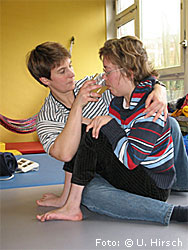Working with Children with Cerebral Palsy
According to the Castillo Morales® Concept
The Castillo Morales® concept also has much to offer in the context of working with and supporting children with cerebral palsy.
The important prerequisites here include many years of experience working with children with cerebral palsy as well as extensive experience with the Castillo Morales® concept. Many elements of the Castillo Morales® concept can be successfully applied. These include notions relating to parent work, communication, posture, alignment and eating and drinking.
Exercises that involve exposure to asymmetrical positions and movements can be especially beneficial for children with CP. It warrants pointing out, however, that therapists should take special precautions because too much asymmetry can block a child’s development.
In general, careful observation, reflection and adaptation are essential when working with children with CP.
Therapeutic Cases
1. L. :
The first three images show 6-year-old L.:
- Sitting in her wheelchair
- Together with the therapist in a reference position that facilitates the swallowing process and other functions
- Engaged in an exercise that begins with the reference position
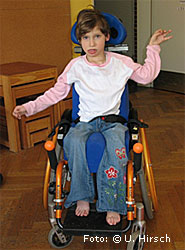
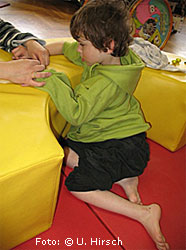
L. in horseshoe seat
An asymmetric sitting position outside of the wheelchair gives L. an opportunity for independent action and allows her to sit almost without assistance. At the same time, sitting in the horseshoe seat encourages weight shifting and rotation, which activate diagonal muscle chains. This is an important building block in the physical empowerment of children with CP.
Here, L. is given an opportunity to handle things and to adjust the position of her head and eyes accordingly. She can rest her head whenever she tires. This position also offers her support when eating and when communicating eye to eye with her therapist.
This position has a tone regulating effect on L.’s body that extends all the way to the orofacial complex. This in turn supports lower jaw rotation and mouth closure, and thereby makes it easier for L. to eat (i.e. to bite small pieces off of larger pieces of food, to chew, and to swallow). L. is essentially given an opportunity to acquire an expanded range of functional skills.
L. in horseshoe seat and resting her head on her cheek
Starting with this position, L. is able to rest her head when she tires and to continue eating. The contact her cheek has to the surface of the seat is also advantageous in that it supports the buccinator mechanism.
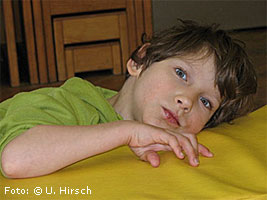
2. M. :
The following images show 15-year-old M.:
- Sitting in her wheelchair
- Drinking in her wheelchair
- Engaged in a therapeutic session
M. in her wheelchair
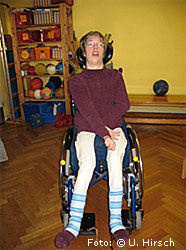
M. in her wheelchair, drinking
M. drinks with a straw.
She is able to close her lips for brief periods and to drink.
When doing so, her muscle tone increases and her breathing rate accelerates.
She sometimes chokes while drinking, especially when she’s excited.
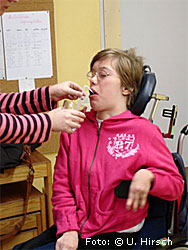
When engaged in the relevant therapeutic session, M. succeeds in drinking quickly and without choking. This is possible because the sitting position, the sharp angle of her hips and knees, and the shoulder-girdle support she receives from the therapist allow her to regulate her overall muscle tension. The asymmetric position and support administered from the side allow her to easily adjust and hold her cervical spine and head in an advantageous position. This position also facilitates breathing and speech. Unburdened, M. is able to form longer sentences.
